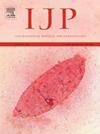Different life strategies of closely related louse species in sympatry: specialist and “generalist“ lineages of Polyplax serrata
IF 3.2
2区 医学
Q1 PARASITOLOGY
引用次数: 0
Abstract
The origin and significance of host specificity are intriguing questions in parasitology. In the case of single-host versus multiple-host parasites, this topic integrates with the concept of the specialist/generalist trade-off. We use the model of sucking lice Polyplax serrata and rodent hosts Apodemus, to address these concepts. Polyplax serrata was shown to form a complex genetic structure, with a strictly specific S lineage living on Apodemus flavicollis, and a less specific N lineage on A. flavicollis and Apodemus sylvaticus. Moreover, the S lineage formed two mitochondrial clades with geographically exclusive distributions and a narrow hybrid zone, providing an opportunity to test the hypothesis that hybrids suffer a decrease in fitness. We sampled 451 individual lice from two host species at 103 localities. We used prevalences and intensities as proxies of fitness, which the parasites realize on their host. The S lineage, strictly specific to Apodemus flavicollis, reached significantly higher prevalences and intensities on its host compared with the N lineage. Conversely, the N lineage occurred with high prevalence and intensity on A. sylvaticus but tended to use also A. flavicollis when the louse populations became too dense. We discuss possible mechanisms behind this difference (particularly interspecific competition as a typical phenomenon in the specialist/generalist systems). We conclude that a parasite’s “choice”, not accessibility of the host or interspecific competition, is the main factor affecting the louse prevalences. We suggest that historical differences in geographic distribution of both lice and mice may provide a possible explanation for the observed life strategy differences. In contrast to the convincing picture in S and N lineage prevalences, we did not detect an expected drop in fitness in hybrids. We consider instability of the hybrid zone, or decline in abundance of the respective hosts, as possible explanations for this result.

同域中近缘虱子物种的不同生活策略:血清多毛虱的专科和 "通科 "品系。
寄主特异性的起源和意义是寄生虫学中引人入胜的问题。就单宿主寄生虫与多宿主寄生虫而言,这一课题与专一性/专一性权衡的概念结合在一起。我们利用吸虱多浆虱和啮齿类宿主 Apodemus 的模型来探讨这些概念。研究表明,血清多浆吸虱形成了复杂的遗传结构,其中一个严格特异的 S 系生活在黄腹角雉上,而一个特异性较低的 N 系则生活在黄腹角雉和啮齿目猿猴上。此外,S系形成了两个线粒体支系,它们在地理分布上具有排他性,而且杂交区很窄,这就为检验杂交后体质下降的假说提供了机会。我们在 103 个地点从两种宿主物种中采集了 451 个虱子个体样本。我们使用流行率和强度作为寄生虫在宿主身上实现的适应性的代用指标。与 N 系寄生虫相比,S 系寄生虫在寄主上的流行率和强度明显更高,而 N 系寄生虫在寄主上的流行率和强度明显更低。相反,N系在A. sylvaticus上的流行率和强度都很高,但当虱子种群过于密集时,N系也倾向于使用A. flavicollis。我们讨论了这种差异背后的可能机制(特别是种间竞争,这是专科/专科系统中的典型现象)。我们的结论是,影响虱子流行的主要因素是寄生虫的 "选择",而不是宿主的可及性或种间竞争。我们认为,虱子和老鼠在地理分布上的历史差异可以为观察到的生活策略差异提供可能的解释。与令人信服的 S 系和 N 系流行情况相反,我们并没有在杂交种中发现预期的适应性下降。我们认为杂交区的不稳定性或各自宿主丰度的下降是这一结果的可能解释。
本文章由计算机程序翻译,如有差异,请以英文原文为准。
求助全文
约1分钟内获得全文
求助全文
来源期刊
CiteScore
8.40
自引率
2.50%
发文量
76
审稿时长
23 days
期刊介绍:
International Journal for Parasitology offers authors the option to sponsor nonsubscriber access to their articles on Elsevier electronic publishing platforms. For more information please view our Sponsored Articles page. The International Journal for Parasitology publishes the results of original research in all aspects of basic and applied parasitology, including all the fields covered by its Specialist Editors, and ranging from parasites and host-parasite relationships of intrinsic biological interest to those of social and economic importance in human and veterinary medicine and agriculture.

 求助内容:
求助内容: 应助结果提醒方式:
应助结果提醒方式:


